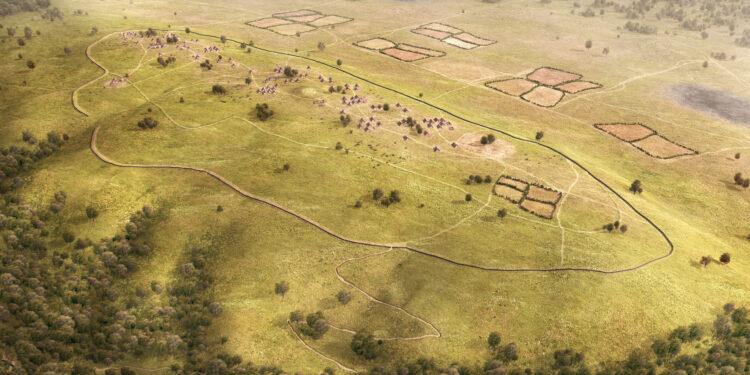Visualization of the situation around 3700 BCE. Credit: Magistrate der Stadt Hofheim; LEIZA-Leibniz-Zentrum für Archäologie, Architectura Virtualis 2020 www.leiza.de/kapellenberg
Since the end of the last ice age, human population growth has been far from uniform, with periods of rapid expansion followed by sharp declines. The reasons for these fluctuations are only partially understood.
Previous research by Peter Turchin, Daniel Kondor and an international team of CSH collaborators has shown that social conflict, rather than – or in addition to – environmental factors, may have had a significant impact on these patterns. Now, they add a new piece to the puzzle.
Wars and conflicts not only cause direct losses, but also create a climate of distress and fear. This fear, by affecting where and how people settle, may have had a significant influence on population trends in Europe, as shown by a study published in the journal Royal Society Journal Interface.
Flight and overpopulation
“Scientists around the world have studied and debated the presence and role of conflicts in prehistory. However, it is still difficult to estimate their effects, especially on the population,” says Daniel Kondor of the CSH. “The task is further complicated by potential indirect effects, such as people leaving their homes or avoiding certain areas out of fear.”
According to the study’s findings, these indirect impacts of conflict may have caused significant and long-term demographic fluctuations in non-state societies, such as in Neolithic Europe (c. 7000–3000 BC).
“Our model shows that fear of conflict led to population declines in potentially dangerous areas. As a result, people concentrated in safer places, such as hilltops, where overpopulation could lead to higher mortality and lower fertility,” Kondor says.
Corresponds to archaeological evidence
The ongoing threat would prevent settlement of much of the remaining land. Detlef Gronenborn, co-author of the study and a member of the Leibniz Centre for Archaeology (LEIZA) in Mainz, Germany, says: “The results of the simulation studies correspond well with empirical evidence from archaeological fieldwork, such as the Late Neolithic site of Kapellenberg near Frankfurt, dating to around 3700 BC.
“As there, we have many examples of temporary abandonment of open agricultural land, combined with a withdrawal of groups to well-defended locations and considerable investment in large-scale defensive systems such as ramparts, palisades and ditches.”
“This concentration of population in specific, often well-defended, locations may have led to disparities in wealth and to growing political structures that justified these differences,” adds Peter Turchin of the CSH. “In this way, the indirect effects of conflict may also have played a crucial role in the emergence of larger political units and the rise of early states.”
Complexity Science Meets Archaeology
To simulate population dynamics in Neolithic Europe, the researchers developed a computer model. To test the model, they used a database of archaeological sites, analyzing the number of radiocarbon age measurements from various locations and periods, assuming that this reflects the scale of human activity and therefore, ultimately, population numbers.
“This allows us to examine the typical amplitudes and time scales of population growth and decline across Europe,” Kondor says. “Our goal was for our simulation to reflect these trends.”
In the future, the model could help interpret archaeological evidence, such as signs of overpopulation or land use patterns, which in turn can provide the context and data needed to further refine the modeling. This is a typical example of interdisciplinary collaboration that the CSH wants to encourage.
“Using complex scientific methods, we develop mathematical models to analyze the rise and fall of complex societies and identify common factors,” Turchin explains. This involves collecting vast amounts of historical data, managed in specialized databases such as the Seshat Global History Databank.
“To get as complete a picture as possible, direct collaboration with archaeologists is extremely important. This study is an excellent example of the potential that such interdisciplinary collaboration can offer,” Kondor emphasizes.
More information:
Landscape of fear: Indirect effects of conflict may explain large-scale demographic declines in non-state societies, Royal Society Journal Interface (2024). DOI: 10.1098/rsif.2024.0210. royalsocietypublishing.org/doi….1098/rsif.2024.0210
Provided by Complexity Science Hub Vienna
Quote: Study links fear of conflict to demographic changes in Neolithic Europe (2024, August 28) retrieved August 28, 2024 from
This document is subject to copyright. Apart from any fair dealing for the purpose of private study or research, no part may be reproduced without written permission. The content is provided for informational purposes only.



